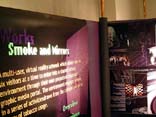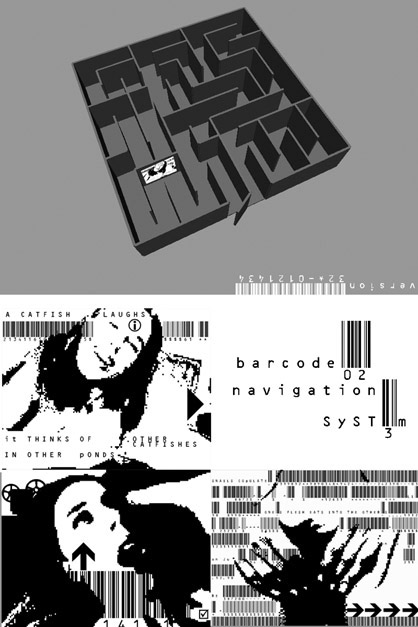|
|
||||||
| image | activities | contacts | links | italiano | ||||||
|
|
||||||
|
introduction |
At UCSD, the Center for Research in Computing and the Arts (CRCA) has
been fostering the development of new forms of culture that arise out
of the development of digital technologies for the last 30 years. We
are now collaborating with a wide range of disciplines to create a new
research institute - the California Institute of Information Technologies
and Telecommunications - Cal-(IT)2, whose specific mission is the deployment
of the internet throughout the physical world. For this new institute,
I head up the New Media Arts area which will encapsulate CRCA activities.
This relationship between the physical world and the realm of information
and media creates new ways to conceptualize forms that intersect architecture
and mediation. With these ideas we also have created the Interdisciplinary
Computing in the Arts Major, where we pedagogically impart the knowledge
base out of which new forms of culture will be created. The synergies
between these various programs are explored in various research studios,
the results of which are on display for this exhibition. Sheldon Brown, Director |
 Installation at the Stazione Leopolda, Florence (photo by: Omar Cotza) |
||||
| StudioLab Instructor: Sheldon Brown http://crca.ucsd.edu/~sheldon/studioLAB/index.html |
||||||

The Sheldon Brown StudioLab: a hybrid Atelier/Technology Development Studio at UCSD, in conjunction with the Center for Research in Computing and the Arts and representing the New Media Arts Layer of the California Institute of Information Technologies and Telecommunications – Cal(IT)2. In the Sheldon Brown StudioLab, we create hybrid forms of culture at the intersection of new media, public space, architecture and art. Underlying this work is the engagement of digital technologies as a translational medium that allows for a mutable exchange of forms, sensibilities and gestures. Modeling, simulation and software become the common threads of discourse that shape the way we approach the crafting of temporal and spatial event space. Cinema is spatially modeled as architectural levels, temporally driven by game engines in multi-user theaters. Public space is architecturally formed by the externalized narratives of interactive technology. Spatial form is algorithmically generated to optimally contain temporal events. The act of modeling - with all of its implications in simulation, play and iconization - becomes the significant object gesture of physical space, creating sublime transformations of material, form and content. Games become the synergistic form of our cultural moment –re-mixing temporal and spatial expressive strategies– a collapse of the architectural and the cinematic, mediated through the common medium of software design. This reformation of cultural form provokes a reform in cultural process. The engineering lab, the art academy, the media production crew, the atelier – each of these models has efficacy as problem solving structures for fixed boundary disciplines. But now software structures undercut old line hardwired forms - we roll our own disciplines and forms as we see fit. We approach our own practices with both disciplinary mutability and organizational fluidity. Works shown in the Image/Architecture exhibition come from these approaches. They are the result of investigations into these hybrid cultural forms, and are the result of hybrid creative approaches, each by working participants of the Sheldon Brown StudioLab. This exhibition consists of highlights from the following projects out of the StudioLab: Istoria-Sculptures, Models and Furniture (Sheldon Brown, with assistance from David Poulin, Joel Murphy and Alex Dragelscu). Overt collisions of algorithmic process, virtual form and material properties are the montage elements in digital, post-Eisensteinian strategy of object formation. Barcode Navigation System (Alex Dragelscu). Commerce code provides hopeful coherency to spatial dissonance in this large scale maze where interactive media elements are embedded within the hallways. Barcode scanners navigate the media maze which in turn provides for a trail of bread crumbs leading to escape. Cal-(IT)2 Building Visualization (Sheldon Brown, Matt Hope, Ben Maggos, Craig Donner). A new research institute at UCSD, looks at a comprehensive transformation of the globe by the ubiquitous deployment of the internet into physical space. From chip fabrication to multi-user virtual reality theaters, the architecture is explored through a custom game/simulation environment. Horn (Matt Hope). There are many paths to ubiquitous media. Architectural structures are derived from algorithms of optimal media delivery systems. 1/32 and BMW (David Poulin). Modeling as grasp and critique of material desire. Re-simulating the simulation of desire provides necessary disruptions in our embrace. Smoke and Mirrors (Sheldon Brown, with Wes Middleton, Chris Berg, David Poulin and Craig Donner). Games, architecture and cinematic structures co-mingle in narrative, social space construction. The exhibition was supported in part by the California Institute of Telecommunications and Information Technologies and the Center for Research in Computing and the Arts. Students: Chris Berg, Craig Donner, Alex Dragelscu, Matt Hope, Ben Maggos, Wes Middleton, Joel Murphy, David Poulin. |
Sheldon Brown is an artist and Director of the Center for Research in Computing and the Arts at UCSD, where he is also the head of New Media Arts for Cal-(IT)2, the California Institute of Information Technologies and Telecommunications. His artwork examines relationships between information and space which manifests as public artworks and installations that combine architectural settings with mediated and computer controlled elements. (http://crca.ucsd.edu/~sheldon/) | |||||
| site
hosted by ARCH'IT rivista digitale di architettura www.architettura.it |
||||||
